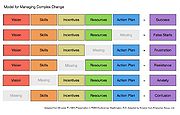Lippitt-Knoster Complex Change Management
(→Abstract) |
(→Abstract) |
||
| Line 1: | Line 1: | ||
| − | = Abstract= | + | = Abstract = |
| − | + | ||
| − | + | ||
| − | + | ||
| − | + | ||
| + | The purpose of this wiki article is to give an overview of the Lippitt-Knoster tool for complex change management, and how this relates to project management. When considering project management, one must also consider that projects are led by people, and that most projects are influenced by some sort of change, whether it being a change in deadline, budget, resources, etc. Thus when working with project management, the project manager must consider the effect of changes and thereby change management. In short, when project management and change management are integrated there is a larger change of success <ref>Prosci, 2020. Best Practices In Change Management</ref> | ||
This paper will include a walk-through of the Lippitt-Knoster model and the different aspects included and considered in the model. | This paper will include a walk-through of the Lippitt-Knoster model and the different aspects included and considered in the model. | ||
| − | The the paper will consider the usability of the model and | + | The the paper will consider the usability of the model and how the model can be used in practice, both prior, during and after a project has been completed. Thus, considering if the model can be used to improve further change initiatives and enhance governance in future projects. |
| − | |||
Then the article will also include aspects of limitations, both in term of usability, but also a consideration of which change initiatives it is applicable to and which it is not. The limitations will also consider the specific change initiatives and the scope of the change it can be used for, which organizational setup which can prove both complimentary to the framework but also conflicting and lastly which challenges specific industries, and there to market sizes, constitute to the model <ref>John Hayes, 2010. The theory and practice of change management</ref>. | Then the article will also include aspects of limitations, both in term of usability, but also a consideration of which change initiatives it is applicable to and which it is not. The limitations will also consider the specific change initiatives and the scope of the change it can be used for, which organizational setup which can prove both complimentary to the framework but also conflicting and lastly which challenges specific industries, and there to market sizes, constitute to the model <ref>John Hayes, 2010. The theory and practice of change management</ref>. | ||
Revision as of 14:31, 19 February 2023
Contents |
Abstract
The purpose of this wiki article is to give an overview of the Lippitt-Knoster tool for complex change management, and how this relates to project management. When considering project management, one must also consider that projects are led by people, and that most projects are influenced by some sort of change, whether it being a change in deadline, budget, resources, etc. Thus when working with project management, the project manager must consider the effect of changes and thereby change management. In short, when project management and change management are integrated there is a larger change of success [1] This paper will include a walk-through of the Lippitt-Knoster model and the different aspects included and considered in the model. The the paper will consider the usability of the model and how the model can be used in practice, both prior, during and after a project has been completed. Thus, considering if the model can be used to improve further change initiatives and enhance governance in future projects.
Then the article will also include aspects of limitations, both in term of usability, but also a consideration of which change initiatives it is applicable to and which it is not. The limitations will also consider the specific change initiatives and the scope of the change it can be used for, which organizational setup which can prove both complimentary to the framework but also conflicting and lastly which challenges specific industries, and there to market sizes, constitute to the model [2].
Big idea
- why project management and change manager are intertwined? - When and what makes a project fail? internal and external uncertainties
- management of people Working with project management, the project manager must be aware of the people included and influenced by the project.
Change management vs. project management
During a project period, It is common that changes occur. This can be in regard to people, resources, timing, budget, etc. For this reason, it is important to account for the effects these changes has on the project and the project team, why change management is an important factor to consider when doing project and in project management.
A change manager uses strategies that focus on individual achievement and change adaptation. A project manager uses processes that focus on meeting benchmarks and achieving clearly defined objectives.
The Model
Vision
Skills
Incentives
Resources
Action Plan
Usability
By integrating CM and PM, it can increase support for the project and reduce resistance.
Application
- How can the model be used? -Why should it be used?
Pre-project
As framework for planning change and projects
During project
-If and when problems/delays/issues occur - can it be shown why?
Post-project review
- How did the project end? - Why / why not was it a succes?
Limitation
As change mangement and project management is different dicisplines in theory, one does not function in practice without the other.
